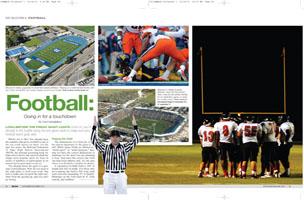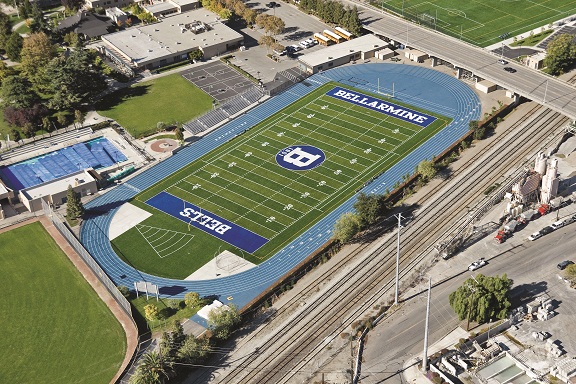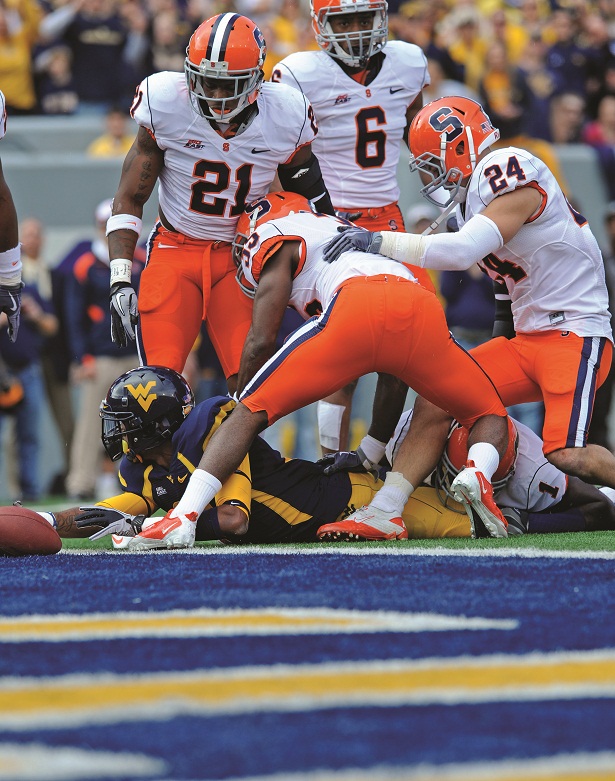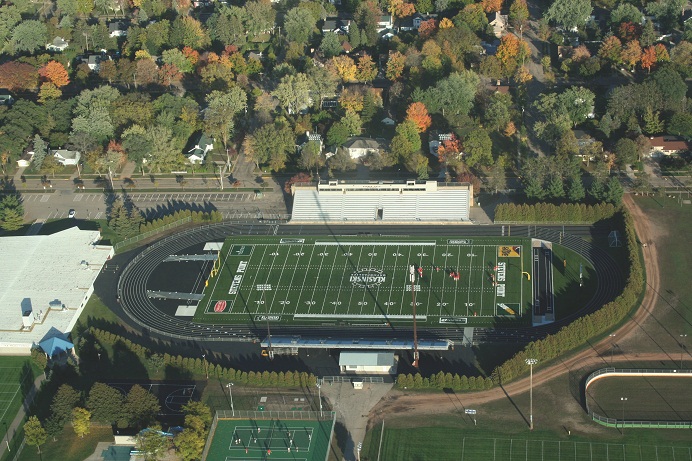
Long before the Friday Night Lights come on, you're already in the huddle doing the pre-game work to make sure your football event goes well.
|
A newly upgraded football field awaits athletes. Playing on a well-tended facility with top-notch amenities can inspire players and boost morale. Photo courtesy of Verde Design, Inc. |
What's not to like? You already have the numbers that prove football is one of the top youth sports out there. For the past two years, the National Federation of State High School Associations (NFHS, the national governing body for high school sports) has rated football the single most popular sport for boys in terms of numbers of participants in its annual sports participation survey.
You already know the sport is a genuine crowd-pleaser. Now all you need is the right place to hold your event. But how to make sure you pick the right one? Start from the ground up, and you can't go wrong.
|
Aspenphoto/Dreamstime.com |
Playing the field
The dimensions of a field are of the utmost importance to the game itself. While many fields are labeled as "multi-sport" or "multi-purpose," they may not have the correct dimensions or markings for the sport you are planning to host. And since the correct size field can help keep athletes safe, it's one area where you should be a stickler for details.
|
A college football stadium, such as this shown here, m ay be the perfect facility for an exhibition game or even for a skills camp. Photo courtesy of Recreational Design & Construction, Inc., Ft. Lauderdale, FL |
A regulation football field is 360' in length and 160' in width. (For those who are counting, the field is 300' long, with each end zone measuring 30' in length). Markings on the field must be 4" wide exactly, and endlines and sidelines must be at least 4". There must also be a safe overrun area outside the lines. Other dimensions apply, including those pertaining to the coaching box and team area; obtain a copy of the rules both for the state(s) the game will be contested in, and those of the national governing body. Remember that rules do change periodically, so make sure you have the most updated information available.
Note: If multiple teams will be playing simultaneously, you’ll need multiple fields. Facilities with lighting can extend the playing day and accommodate more games, or events that go into overtime.
"For the participants (athletes, students, cheerleaders, etc.), much of the focus is on the playing surface itself and the amount of it," says Tony Wood of Verde Design Group in Santa Clara, California. "The addition of space outside the stadium setting and adjacent to a field can go a long way and allows teams to warm-up, run drills and use the equipment without taking up space on the field."
On the surface
A football field may be made of natural grass or synthetic turf. Both are acceptable for play, and both have their advantages and disadvantages. Make sure the field is correctly sloped for the type of surface and that it drains well. (Check with the facility manager to find out about the weather you will likely encounter during your event, and whether or not the field will have to be closed to allow it to dry out, should there be inclement weather).
Whichever the surface, it must be kept in shape. Grass requires weeding, watering, fertilization and mowing. Its fields cannot be played on constantly without a ‘rest period’ which allows it to recover. Find out if another event will have been played recently, since that can affect the quality of the field. Artificial turf, though it does not need to rest, should be cleaned, groomed and sanitized regularly. Both fields will need to have adequate water drainage to ensure playability.
|
This municipal football field is in close proximity to tennis courts and other athletic areas. Photo courtesy of Rettler Corporation, Stevens Point, WI |
Practice Equipment
If your event is a sports camp or skills clinic, or if you'll be holding practices, certain equipment will be necessary. Sleds, tackling dummies, mats, bag trainers and target trainers (these include nets, hoops and other devices) will be used. If your event will use other forms of strength training, a weight room is desirable. A room that can be used to show DVDs can also be a plus. Remember that different age groups will require different types of, and sizes of, equipment.
Many athletic fields are encircled by running tracks. If you plan to use these facilities for training, check with the facility manager since certain types of footwear, including cleats, can damage all-weather track surfaces.
Sam Fisher of Fisher Tracks in Boone, Iowa notes that event owners should make sure gates leading to tracks work to allow football players and personnel to enter and exit the field, since "oftentimes gates are placed appropriately for the running track athletes, which is an inappropriate placement for other sports."
The setting
If you've narrowed your choices to a few options, it's time to do side-by-side evaluations of facilities Don't forget to consider:
· Parking: Spectators, officials, team personnel, (and depending upon the level of play, scouts appearing on behalf of schools or teams) will all want to be close to the facility.
· Spectators: The wider the field (a regulation soccer field, for example, is a good 50' wider than a football field), the further spectators will be from the action. A regulation football field gives spectators a better view.
· Seating: There should be separate seating for players (and team personnel), spectators and officials. Temporary or portable bleachers can be used if space permits. ADA considerations apply.
· Locker rooms: Football is an equipment-heavy sport; players personally need uniforms, padding, helmets, shoes and more, as well as clothing to change into once the games are over. All this equipment must be stored safely and securely. Players also need a place to change, shower, etc.
· Conveniences: On-site rest rooms (or portable toilets and hand sanitizing stations) are necessary. Refreshment stands are important too. Booths for souvenir sales will allow teams to fund raise.
· Amenities: Public areas should be well-lit. A public address system is necessary, as is a score board with a clock.
· Emergency Facilities: If the venue does not have a first-aid tent or office, it must be accessible to emergency personnel.
· Media-Friendly: Expecting media? Look for a facility with a working press box including electricity, phones and wi-fi.
· Tailgating: Will your event draw the tailgate crowd? If so, you'll want a place with bathroom facilities nearby. Secure all permits in advance.
· Weather: If an important competition is scheduled and the weather is iffy, have an emergency back-up site, such as an indoor arena. Depending upon the playing surface, some facilities may require players to wear flat-bottomed shoes.
· Officials: Game officials should know the rules for the sport with regard to the governing body and age group being hosted. The local high school or collegiate athletic association, rec council, etc. can help point you in the right direction. For an event being held during a busy sports season, officials’ time should be reserved in advance.
When you lay the groundwork in advance, you're the one who scores big at the end of the game.





